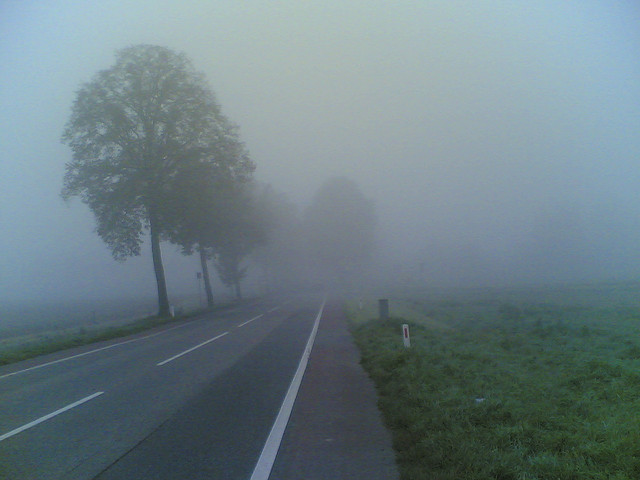


The rotor down wash picks up particles and re-circulates them through the rotor down wash.This effect typically occurs when a helicopter takes off or lands on a snow-covered area.White out has been the cause of several aviation accidents.Flying is not recommended in any white out situation.A white out situation is severe in that there are no visual references.There are no shadows, no horizon or clouds and all depth-of-field and orientation are lost.The glow is a result of being surrounded by blowing snow, dust, sand, mud or water.As defined in meteorological terms, white out occurs when a person becomes engulfed in a uniformly white glow.In night landings, aircraft lighting can enhance the visual illusions by illuminating the brownout cloud This can also cause the pilot to make incorrect control inputs which can quickly lead to disaster when hovering near the ground. Helicopter rotor wash also causes sand to blow around outside the cockpit windows, possibly leading the pilot to experience an illusion where the helicopter appears to be turning when it is actually in a level hover. A pilot not using the flight instruments for reference may instinctively try to level the aircraft with respect to the false horizon, resulting in an accident. Blowing sand and dust can cause an illusion of a tilted horizon.This is particularly dangerous because the pilot needs those visual cues from their surroundings in order to make a safe landing This is a dangerous phenomenon experienced by many helicopters when making landing approaches in dusty environments, whereby sand or dust particles become swept up in the rotor outwash and obscure the pilot's vision of the terrain.Intense, blinding dust clouds stirred up by the helicopter rotor downwash during near-ground flight causes significant flight safety risks from aircraft and ground obstacle collisions, and dynamic rollover due to sloped and uneven terrain The brownout phenomenon causes accidents during helicopter landing and take-off operations in dust, fine dirt, sand, or arid desert terrain. The following factors will affect the probability and severity of brownout: rotor disk loading, rotor configuration, soil composition, wind, approach speed, and approach angle.This can cause spatial disorientation and loss of situational awareness leading to an accident In a brownout, the pilot cannot see nearby objects which provide the outside visual references necessary to control the aircraft near the ground. A brownout (or brown-out) is an in-flight visibility restriction due to dust or sand in the air.Flat light conditions can lead to a white out environment quite rapidly, and both atmospheric conditions are insidious they sneak up on you as your visual references slowly begin to disappear.However, with good judgment and proper training and planning, it is possible to safely operate an aircraft in flat light conditions.As a result of this reflected light, it can give pilots the illusion that they are ascending or descending when they may actually be flying level.Flat light can completely obscure features of the terrain, creating an inability to distinguish distances and closure rates.Such conditions can occur anywhere in the world, primarily in snow covered areas but can occur in dust, sand, mud flats, or on glassy water.Flat light conditions are usually accompanied by overcast skies inhibiting any visual clues.

It is not as severe as "white out" but the condition causes pilots to lose their depth-of-field and contrast in vision.Flat light is an optical illusion, also known as "sector or partial white out".Flying in Flat Light, Brown Out Conditions, and White Out Conditions:


 0 kommentar(er)
0 kommentar(er)
